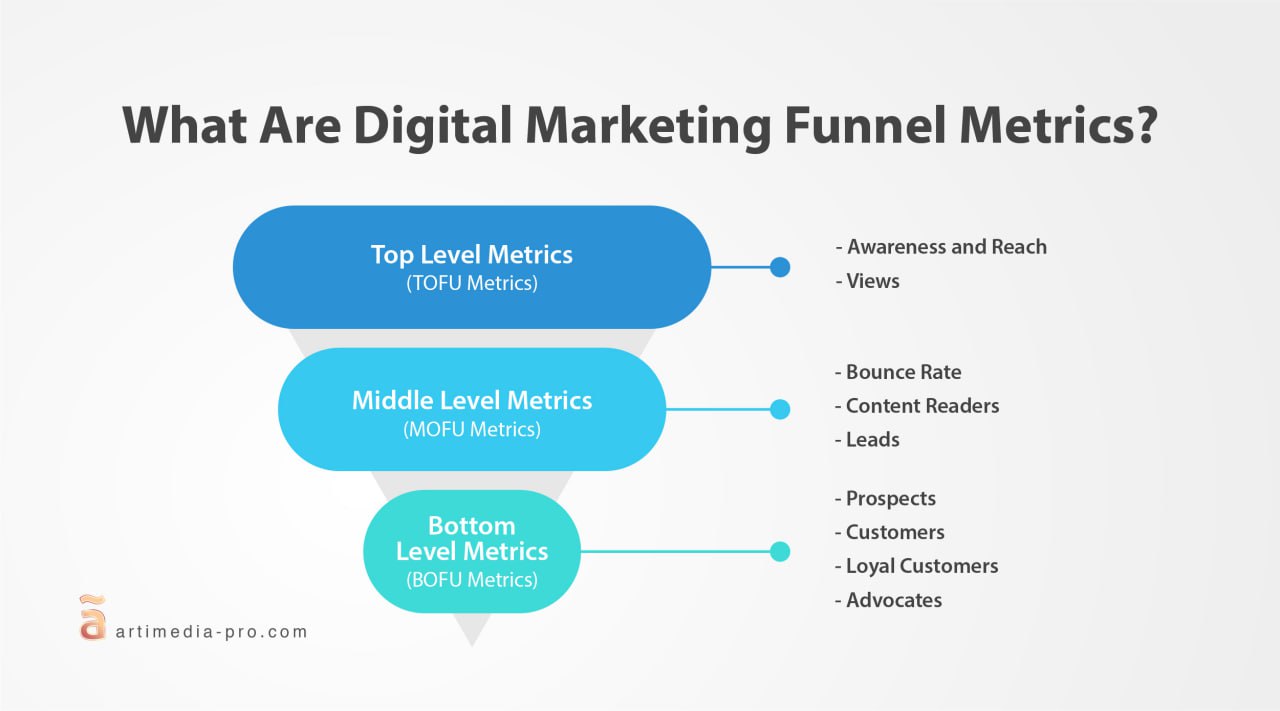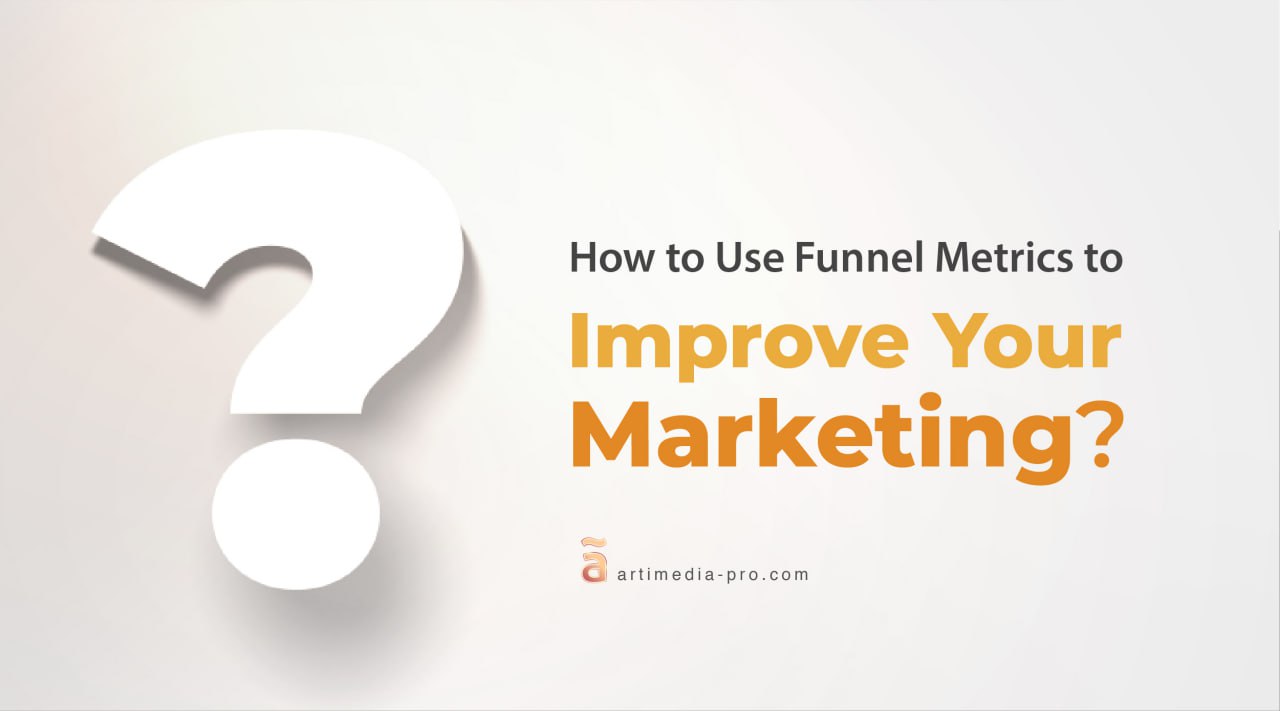Table of Contents
Digital marketing funnels help you to guide your targeted audience and prospects throw their journey with your brand, however, to follow up this journey and guarantee that everything is working as should be you need to regularly measure your digital marketing funnel metrics.
Even after taking action and starting your full-funnel digital marketing, your work is not done yet, as you should monitor the funnel indicators to guarantee everything is going in the right direction.
In this blog, we are going to share with you the most important digital marketing funnel metrics that you should keep an eye on to know what is working right and what needs adjustment.
What Are Digital Marketing Funnel Metrics?
As we said the digital marketing funnel is your way to turn your targeted audience into customers and then into loyal ones as well, with all the power and control you can do in your digital marketing funnel strategy.
However, for so many reasons you must measure this funnel success with the right digital marketing funnel metrics to guarantee your success and revenue:
- Awareness and Reach.
- Views.
- Bounce Rate.
- Content Readers.
- Leads.
- Prospects.
- Customers.
- Loyal Customers.
To help you understand these metrics, their levels, and their attached details better, we are going to include a deeper explanation of these digital marketing funnel levels and the attached metrics of each one.
Top Level Metrics (TOFU Metrics):
These digital marketing funnel indicators help you to know where visitors are coming from, and to know where you should focus and invest more, whether on email campaigns, guest posts, or social media.
Moreover, supports you with real information about your audience’s favorite online channels, and how to choose the best social media platforms for your business based on your audience’s existence.
-
Awareness and Reach:
This metric is about knowing who you are reaching and how your efforts are empowering your brand awareness and exposure in a positive way.
Usually, this digital marketing funnel metric is measured with social media reach, ad impressions (usually measured in thousands of views), and keyword searches.
-
Views:
Who saw your marketing work, where they live, when, what are their demographics and so other many details that you should specify based on your brand to measure the views of your funnel.
However, to follow your views number you must check your website traffic from organic search engine searches or Google Ads, landing page clicks, and social media posts.
Middle Level Metrics (TOFU Metrics):
At this point of the funnel, your leads are more interested in what you are offering to them and started to consider buying from you.
However, to reach this point you must know what interests your targeted audience, and what the most effective CTA to use for your customers to boost their engagement and use this type more effectively.
-
Bounce Rate:
Bounce rate is the percentage of people visiting only one page on your website, as this digital marketing funnel metric shows the interest rate in your brand from people reaching your website.
Moreover, this is also considered an indicator that website visitors like what they saw on that page and become interested in checking other pages too to know what you are offering.
-
Content Readers:
Your web visitors, despite where they came from, who spend a longer time on your website (more than 2 minutes) are people interested in what you are sharing and actually reading it.
This can be easily measured with Google Analytics or other analytics software that you prefer to use.
-
Leads:
People who choose to opt-in via a form whether you share this form via e-mail or social media post.
To encourage people to consider signing in for this form you must include an interesting outcome for them, like sharing with them an interesting e-book, new information, or even a discount code for your services or products.
Bottom Level Metrics (BOFU Metrics):
You must know how many people actually reached the final stage of your funnel, as having a low number compared to the entry number will indicate that something is going wrong in the middle, and you should repair it.
Each stage of the digital marketing funnel has its requirements and its own kind of CTA, monitor these conversions to know if you are asking for too much based on your consumer behavior.
Moreover, know whether there is a problem at a specific stage that needs to be fixed to turn your funnel into a successful one.
-
Prospects:
The leads who did not only subscribed to your email newsletters, but also clicked through the link you shared with them to reach the offer, landing page, or the website page you wanted them to reach.
-
Customers:
leads or prospects who actually responded to your offer by completing the purchase process and becoming customers, whether they did one or multiple purchasing processes.
-
Loyal Customers:
The favorite type of customers for all sales and marketing people, as they become your always-buying customers, moreover, they will not buy from another brand as long as you offer what they need.
-
Advocates:
Your brand fans, whether they are customers or not, who spread your content on their own social profiles, hence, helping you to boost your brand awareness.
These customers could be part of your influencer marketing strategy with their large social accounts, or just people with their personal accounts sharing your brand among their friends.
Read more: Popular Digital Marketing Funnel Stages
How to Calculate and Analyze the Digital Marketing Funnel Metrics?
Before starting to calculate or measure your digital marketing funnel metrics, you must set your final goal from this process, and actually, this concept is applied to marketing funnels and sale funnels.
As to how and what you should measure, even if you do have goals to compare to, however, and despite your goals there are 4 basic points to measure when analyzing your digital marketing funnel KPIs.
- Leads.
- Sales.
- Opportunities.
- Customers lifetime value (LTV).
These calculations help you to measure your digital marketing funnel success, moreover, know whether there is any weakness at any stage, more than that, what you should do to fix it and improve your outcomes.
How to Use Funnel Metrics to Improve Your Marketing?
So, as we said you must follow up your digital marketing with real metrics to know what is going on and how your efforts are coming up.
Thus, you must consider these points if you want to benefit from your digital marketing funnel metrics and empower your business:
- Set goals for each stage of the funnelas each stage has a different perfect outcome to reach and you must measure each stage outcome differently.
- Track your progress over time, you must know that the marketing funnel is not only a one-day work, thus, you must set a clear timeline and align the work to each period.
- Identify areas where you can improveto benefit from all the done work and measuring, and ensure getting the best outcomes.
- Optimize your marketing campaigns based on your findings,as you should not follow up to follow up, but to take notes and improve your process based on those results.
One final thought,
Following your digital marketing metrics is an essential step if you want to succeed and improve your digital marketing funnel efforts.
However, you must ensure that all that marketing work is done based on stable and well-studied steps to reach the required results and boost your business revenue.
Thus, contact ãrtiMedia Pro today to reach the best digital marketing funnel strategy and achieve high and positive metrics.




